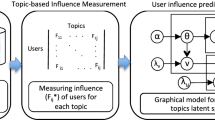Abstract
In this paper, we propose an approach, Role and Topic aware Independent Cascade (RTIC), to uncover information diffusion in social networks, which extracts the opinion leaders and structural hole spanners and analyze the users’ interests on specific topics. Results conducted on three real datasets show that our approach achieves substantial improvement with only limited features compared with previous methods.
Access this chapter
Tax calculation will be finalised at checkout
Purchases are for personal use only
Similar content being viewed by others
Notes
- 1.
- 2.
We define that users who have followed by at least 1000000 are the famous users, others are the normal users.
- 3.
In the following pages, we call these three data sets as “Mo Yan data set”, “Liu Xiang data set” and “Han Han data set.”.
References
Blondel, V.D., Guillaume, J.L., Lambiotte, R., Lefebvre, E.: Fast unfolding of communities in large networks. J. Stat. Mech. Theory Exper. 2008(10), P10008 (2008)
Brin, S., Page, L.: The anatomy of a large-scale hypertextual web search engine. In: Proceedings of WWW 1998. ACM (1998)
Burt, R.S.: Structural Holes: The Social Structure of Competition. Harvard University Press, Cambridge (2009)
Goldenberg, J., Libai, B., Muller, E.: Talk of the network: a complex systems look at the underlying process of word-of-mouth. Mark. Lett. 12(3), 211–223 (2001)
Granovetter, M.S.: The strength of weak ties. Am. J. Sociol. 78, 1360–1380 (1973)
Haveliwala, T.H.: Topic-sensitive PageRank. In: Proceedings of WWW 2002, pp. 517–526. ACM (2002)
Lou, T., Tang, J.: Mining structural hole spanners through information diffusion in social networks. In: Proceedings of WWW 2013, pp. 825–836. International World Wide Web Conferences Steering Committee (2013)
Rogers, E.M.: Diffusion of Innovations. Simon and Schuster, New York (2010)
Si, X., Sun, M.: Tag-LDA for scalable real-time tag recommendation. J. Comput. Inf. Syst. 6(1), 23–31 (2009)
Suh, B., Hong, L., Pirolli, P., Chi, E.H.: Want to be retweeted? Large scale analytics on factors impacting retweet in Twitter network. In: 2010 IEEE Second International Conference on Social Computing (SocialCom), pp. 177–184. IEEE (2010)
Weng, J., Lim, E.P., Jiang, J., He, Q.: TwitterRank: finding topic-sensitive influential twitterers. In: Proceedings WDSM 2010, pp. 261–270. ACM (2010)
Yang, Z., Guo, J., Cai, K., Tang, J., Li, J., Zhang, L., Su, Z.: Understanding retweeting behaviors in social networks. In: Proceedings of CIKM 2010, pp. 1633–1636. ACM (2010)
Zaman, T.R., Herbrich, R., Van Gael, J., Stern, D.: Predicting information spreading in Twitter. In: Workshop on Computational Social Science and the Wisdom of Crowds, NIPs, vol. 104, pp. 599–601. Citeseer (2010)
Zhang, J., Tang, J., Li, J., Liu, Y., Xing, C.: Who influenced you? Predicting retweet via social influence locality. TKDD 9(3), 25 (2015)
Zhao, X., Jiang, J.: An empirical comparison of topics in Twitter and traditional media. Singapore Management University School of Information Systems Technical Paper Series (2011). Accessed 10 Nov 2011
Acknowledgment
This research is supported by NSFC with Grant No. 61532001 and No. 61370054, and MOE-RCOE with Grant No. 2016ZD201.
Author information
Authors and Affiliations
Corresponding author
Editor information
Editors and Affiliations
Rights and permissions
Copyright information
© 2016 Springer International Publishing AG
About this paper
Cite this paper
Ren, X., Zhang, Y. (2016). Predicting Information Diffusion in Social Networks with Users’ Social Roles and Topic Interests. In: Ma, S., et al. Information Retrieval Technology. AIRS 2016. Lecture Notes in Computer Science(), vol 9994. Springer, Cham. https://doi.org/10.1007/978-3-319-48051-0_30
Download citation
DOI: https://doi.org/10.1007/978-3-319-48051-0_30
Published:
Publisher Name: Springer, Cham
Print ISBN: 978-3-319-48050-3
Online ISBN: 978-3-319-48051-0
eBook Packages: Computer ScienceComputer Science (R0)




